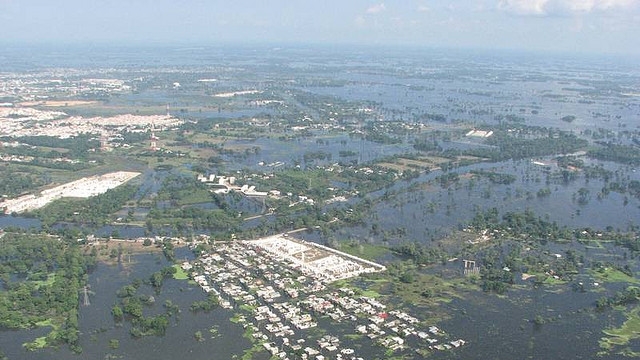Although the 2007 Tabasco floods are an exceptional example of the damage a single natural disaster can cause, natural disasters are commonplace in Mexico. Approximately 41 percent of Mexico’s territory and 31 percent of its population are exposed to a range of natural hazards, including hurricanes, storms, floods, earthquakes and volcanic eruptions. Between 1970 and 2009, natural disasters affected almost 60 million people in Mexico, a figure that could easily increase due to the impact of climate change on the intensity and frequency of natural hazards.
Disasters impose a significant burden on the federal government’s budget. From 1999 to 2011, the cost of post-disaster reconstruction of public assets and low income housing, financed by the federal government, averaged US$1.46 billion per year. The government incurred the highest costs in 2010 when major floods generated rehabilitation needs exceeding US$5 billion. Mexico’s individual states also have a heavy burden to bear as a result of damages caused by disasters. Each year, the 32 states face contingent liabilities of over US$1 million for damages to state and municipally owned assets.
While the occurrence of a natural hazard could be considered exogenous, its transformation into a disaster is not. As Mexico’s population continues to grow, problems such as unplanned and unregulated land use, lack of environmental controls and poor building standards become exacerbated. These challenges, combined with a changing climate and increased climate variability, set the stage for increased losses and damages from natural events.
Mexico and the World Bank
For over a decade, the Government of Mexico and the World Bank have been working together to improve the country’s disaster risk management system and secure its economic and financial standing in the event of future disasters. Mexico has one of the most sophisticated financial protection strategies against disasters amongst middle-income countries, as part of their overall Civil Protection system. Over the years, it has been able to establish, and continuously improve, an effective system for allocating resources for emergency response, rehabilitation and reconstruction, built around the Natural Disasters Fund (FONDEN) and comprised of a variety of risk transfer instruments.
The country’s ongoing commitment to developing innovative and sustainable financial protection strategies against disasters has significantly secured the country’s ability to respond to human and infrastructure needs in the event of disasters. However, effective prevention and risk reduction and its linkages to the overall financial protection strategy against disasters remain the main challenge in disaster risk management for Mexico. Today, the collaboration between the Government of Mexico and the World Bank focuses on supporting this key challenge of gradually shifting from an ex-post response and reconstruction approach to disasters to an ex-ante prevention and risk reduction approach.
A New Programmatic Approach
In 2012, the World Bank renewed its commitment to the Government of Mexico through a new Programmatic Approach in Disaster Risk Management. A Programmatic Approach organizes different activities and projects under one overarching objective. It is designed to establish a more effective collaboration between the World Bank and Mexico’s government by allowing for flexibility and responsiveness to meet evolving needs within a particular subject. This ongoing partnership between Mexico’s government and the World Bank has served to increase the understanding of the country’s major disaster risk management levers; identify constraints and challenges that persist; and strengthen the capacity of key government stakeholders to advocate for, and implement, disaster preparedness and risk reduction measures.
This comprehensive approach is founded on three main pillars:
- Strengthening Mexico’s existing disaster risk management systems.
- Supporting disaster and climate resilience activities across a wide range of sectors.
- Fostering collaboration, exchanges and partnerships around disaster risk management within the region and beyond.
Pillar 1: Strengthening Mexico’s existing disaster risk management systems
Under Pillar 1, the Government of Mexico and the World Bank seek to deepen understanding and broaden integration of disaster risk reduction measures in federal investments and improve monitoring and evaluation of financial protection strategies against disasters. They also aim to strengthen the capacity of state-level governments to assess, understand and manage fiscal disaster risk. Some activities involved in this process include:
- Analyzing the Federal Government’s investments in prevention and disaster risk reduction over a five-year period.
- Assessing the use of hazard and risk information - including geo-spatial, financial, actuarial and socio-economic information - in the Federal Government’s decision-making on disaster risk prevention and reduction.
- Assessing the impacts of investments through a number of case studies, as in the case study of Tabasco (see below).
- Formulating a strategy for integrated disaster risk financing at the subnational level through the development of a joint catastrophe risk transfer mechanism for Mexican States.
Disaster Risk Reduction and Prevention: The Case of Tabasco
In 2007, following the debilitating floods in Mexico’s state of Tabasco, President Felipe Calderon pledged to rebuild. Through the National Water Commission (CONAGUA), the federal government and the government of Tabasco worked together to design and implement the Integrated Hydraulic Plan of Tabasco (PHIT for its acronym in Spanish) which included short and medium term measures to reduce the risk of floods. These measures involved improving the overall hydraulic infrastructure of the state, optimizing the use of water resources and relocating the population to areas less prone to flooding.

